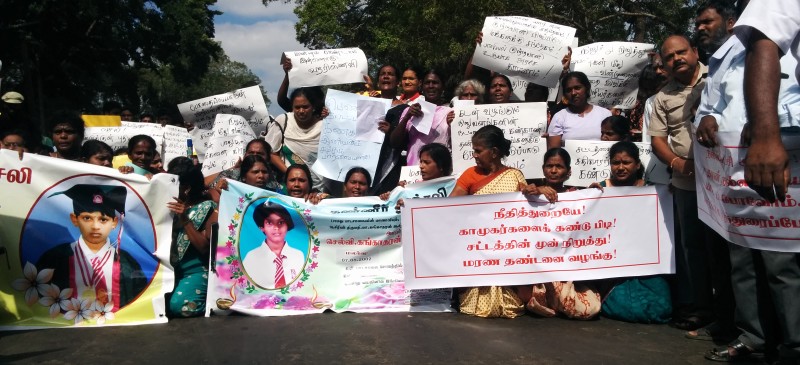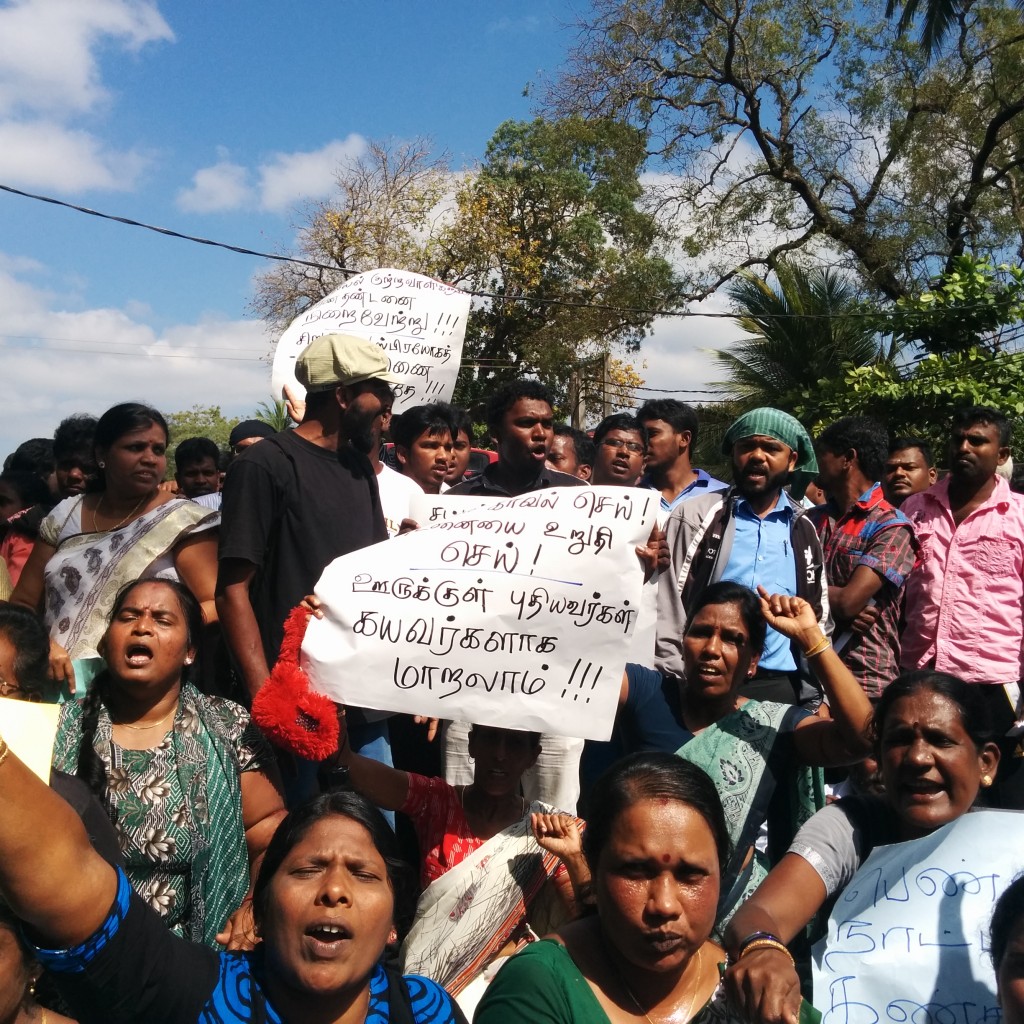As women’s rights groups and activists mark International Women’s Day tomorrow (8th) and the month of March as ‘Dark March’[1], we hope that we can take a long, hard, reflective look at ourselves and our actions and decide to join the long, hard struggle to end violence against women and children in Sri Lanka.
The rape and killing of little Harishnavi
On the 16th of February, 2016 afternoon, 13 year old Kankatharan Harishnavi, was found raped and killed at her home in Ukkulankulam, Vavuniya. A bright young student of Vipulananda Vidyalayam, Vavuniya, Harishnavi had stayed home from school that day as she was feeling slightly unwell, and had complained to her mother that her new uniform was too short for her. As the school bell had rung by then, and her mother who was also a teacher at the school had to leave for school, she had told Harishnavi to stay indoors, and left for school with her two other children (aged 15 and 10), at about 7.50am.
As her mother’s time-table had been quite full, she was unable to come home before the end of the day, so when she came home after school around 2.15pm and was parking her bike, her son had walked into their home and run out shouting for their mother to go inside and see what had happened to his sister. When the mother had run inside, she’d seen her daughter standing upright, about a foot off the floor, with a saree wrapped loosely around her neck, with the other end tied to the roof. Thinking that her child was just playing around and trying to scare her, she had immediately removed the saree, at which point her daughter’s body had fallen to the floor. The mother had immediately picked her up and laid her down on the bed assuming that she had fainted, whilst instructing her son to go fetch help to take Harishnavi to the hospital. Meanwhile a doctor from a nearby private clinic had come and checked on her and pronounced her dead.
Thereafter, the Police had appeared on the scene and carried out inquiries, and the Coroner had come and checked the body and taken it from the house. There had been some bite/teeth marks on her stomach.
Clothes and books were strewn all over the floor and the wall clock had fallen to the floor and stopped at 11.30. There had been no chairs or anything she could have climbed onto to tie herself to the roof said the family, when people speculated that she might have committed suicide. The family had also found a plate of food served, mixed together and left untouched on the kitchen floor, with all the pots and pans still with their lids off, almost as if Harishnavi had been called out by someone, the family said. When the neighbours were asked if they had heard any noise, they said they had not heard anything.
The JMO report released on the 19th of February, 2016, stated that Harishnavi had been raped and killed by strangulation.
The family said that they had no enemies and that they didn’t suspect anyone, but, that they had some boundary fence issues with their immediate neighbor and that they were not on talking terms. The family also mentioned a young local man living abroad, now on holiday in Sri Lanka, who would frequent the cycle shop next door, and how he had disappeared from the village after the incident. The Police had taken in the neighbours for questioning, but had released them soon after, and have now arrested the owner of the neighbouring cycle shop, and are in the process of questioning him.
Harishnavi’s father had left for India in 2007 and thereafter moved to Germany, where he still resides. The family had applied for visa last year but, been rejected, and were going to re-apply this year.
The family said that whilst cleaning out the room they had found a blood soaked Cotex (sanitary napkin) in the corner of the room, but that Harishnavi was not having her period at the time. Therefore, they assume that the perpetrator had used it to mop up any blood from the floor. The family had put the Cotex (brand of sanitary napkin) and everything else they found whilst cleaning up the room in a bag, in case the Police needed anything for their investigations.
“Harishnavi was such a gentle sort, quiet and studious – she even got 170 marks at her Grade 5 Scholarship examination. She rarely studied at home but, was able to retain everything she learnt at school. She was very friendly with everyone and loved animals. She loved to watch TV and didn’t like doing much house work, but she’d never bother anyone” her aunt said fondly. She would take part in district competitions in Social Sciences and also the Maths and Science Olympiad.
The Culture of One-Offs
On the 23rd of February (Tuesday), large crowds of angry parents, teachers, activists, clergy and local societies took to the streets in protest of the rape and killing of 13 year old Harishnavi. More than 500 people marched through the town from Gamini Maha Vidyalayam to the District Secretariat Office, Vavuniya, demanding justice for the rape and killing of Harishnavi and all others cases of violence against women and children.
Last year, the rape and killing of 18 year old Sivaloganathan Vithiya from Pungudutivu, sparked large scale protests across the country. Even President Sirisena visited Vithiya’s family in Jaffna and assured them that a Trial-at-Bar[2] would be set up to ensure they receive speedy justice for the senseless rape and killing of their daughter. Almost a year later, with 10 suspects in custody, the family is yet to see justice. Similar spontaneous and organized protests have taken place after most such cases of rape and killing of women and children. The gang rape and killing of Saranya, the rape and killing of 13 year old Luxmy from Delft, the rape of two school children from Karainakar by the Navy, the killings of little Seya and Jerusha….and the list of protests following such cases go on and on. And the results of these protests, public statements, articles, petitions, letters to the President etc., have all been the same. The police make some arrests, appoint multiple teams to “investigate” into the incidents, Government authorities make public assurances to end violence against women (depending on the “profile” of the case of course,) and then once the momentum dies down, the latest case like most other cases before it, sinks into the ‘black-hole’ that is our justice system.
Legal, social and economic injustices faced by victim families and survivors
[dropcaps style=”e.g:style-1 or style-2 or style-3″ fchar=””]Our justice system crippled by its own back log of cases, the methodology followed during the entire court process including lack of witness and victim protection, harassment of witnesses during trial by defense attorneys and untrained police officers to do professional investigations in to cases of sexual violence, have been slow at handling cases on sexual violence.[/dropcaps]
This is not to imply that there have been no convictions over the years, i.e. the cases of Jesudasan Rita (Dec. 2015), a 27 year old mother from Vishwamadu (Oct. 2015), Divya (May 2012), but they have been very few and far between. Hence it does not act as an effective deterrent to cases of such nature.
One of the gravest aspects of this entire issue is that at every juncture, be it legally, socially or culturally, it is the victim, survivor and their families that are most vulnerable. Whilst legally, the system almost seems to protect the perpetrator, by way of rape still being a bail-able offence, constant delays by the Police and the courts, and a complete lack of protection for survivors and their families. Socially and culturally, we are positively brutal. Society is ever ready to place the entire blame of rape or sexual violence on the victim or survivor, stigmatize and ostracize them from society and victimize them all over again. This behavior by the society at large not only contributes to protecting the perpetrator, but also to perpetuate a culture of impunity.
We also teach our children to uphold and pass on all the wrong values, as they are made to believe that the victim/survivor of sexual violence somehow brings it upon themselves. A further obstacle survivors and their families face is the practical difficulty and economic burden of pursuing justice, as most cases are dragged on for multiple years. This is yet another blatant indicator that there is no systematic or community-based support mechanism for such families. These challenges coupled with the intimidation faced by families, by perpetrators out on bail or their goons, makes it almost inevitable that most families are unable to pursue justice.
Supporting victim families and survivors
However, families do, and have courageously withstood intimidation and relentless pursued justice. Some have succeeded after years and years of waiting, whilst some still continue to wait. We, as a society must applaud their courage and support them in their struggle, instead of shunning and stigmatizing them. We should work with local organizations and families to volunteer our time and support to accompany families to court and show our solidarity, initiate fundraising campaigns to cover their legal, travel and other related costs, sustain media and community pressure on government departments and the judiciary to expedite convictions and stop delays etc.,.
The passion and commitment of local women’s rights activists and others, although largely unsung, is awe-inspiring and we have the deepest respect for their work. However, this is not a struggle that they alone can accomplish. The state of violence against women and children in Sri Lanka, is our collective reality. The only way by which we can achieve any significant success in this regard, is if we also realise the collective responsibility – the government, the criminal justice system and society as a whole.
So, the question here should not be, if or not we should protest, but rather, that we recognize that protests are an integral part of the process, but, that it cannot achieve much on its own. Whilst fully understanding the multiple difficulties faced by activists, most of whom are already spreading themselves very thin, the main challenge before us is how to move beyond the one-off protests, meetings, write-ups and appeals, and identify creative and practical means by which to commit to, and spearhead this long-term struggle. Until and unless we, the general public, take ownership of this struggle, and realise that it’s only then that real change can come about, we will never be rid of this problem. There’s no quick fix to ending violence against women and children. It’s a long and winding road and we need to go the distance together. It really is as simple or impossible as that.
[1] Journey Towards Justice, Dark March Campaign – https://www.facebook.com/JourneyTowardsJustice/posts/600971690050331
[2] Daily Mirror, Maximum punishment for perpetrators – President in Jaffna – http://www.dailymirror.lk/73839/maximum-punishment-for-perpetrators-president-in-jaffna

